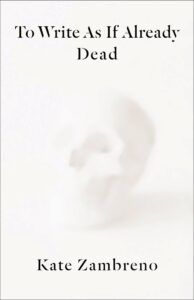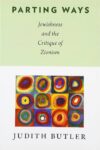
[Columbia UP; 2021]
Opening a book by Kate Zambreno — any one of her books — is akin to opening a large map. The folds and creases mark out a potential exploration, from one section of paper to the next, but the patterns on the page elicit the shock of a radical reorientation. Roads stop looking like roads, a familiar forest becomes a mass of green. Estrangement is illumination. It’s mesmerizing, alienating. Perhaps akin to examining oneself in the mirror: the forms are unrecognizable but draw one’s attention all the same. When I open a book by Kate Zambreno, the first thing I do is thumb through the pages to see how the text is laid out. Are there unnumbered sections, like in Book of Mutter, her 2017 textual meditation on the loss of her mother, modelled after Louise Bourgeois’s Cells sculptures? Is the writing broken down partly as an index of years, like in her 2012 book Heroines about the writing lives of the wives of modernist authors? Is the text organized as a ladder of appendices, as in her 2019 Appendix Project, an assembly of talks and essays marking the ongoingness of a preoccupation and its necessary unfinishedness, following the publication of Book of Mutter? What about the diaristic islands of paragraphs and photographs in her novel Drifts, which is divided into a series of parts, entitled, for instance, “Sketches of Animals and Landscapes” and “Vertigo”?
The forms Zambreno adopts are responses to the questions being posed, which appear similar from afar, as a curdle of certain preoccupations, but are nevertheless distinct, as determined by the form: what necessitates the book as paragraphs and photographs instead of an index instead of an appendix instead of a list instead of a chapter. The same people appear over and over again and the same themes too, like manicula — Sofia Samatar, Marguerite Duras, WG Sebald, Louise Bourgeois, Bhanu Kapil, Walter Benjamin, women’s bodies, madness, abjection, the self in relation to the world that makes it and is made by it, the family unit, precarity, money, motherhood, memory, grief, photography, beauty, terror and, of course, writing.
Zambreno’s latest, To Write as if Already Dead, sits snugly alongside her existing repertoire. The book is a part of a series called Rereadings, responding to post-1970 novels from the perspective of the present. Zambreno’s text responds to Hervé Guibert’s 1990 autofiction novel To the Friend Who Did Not Save My Life (published originally in French as À l’ami qui ne m’a pas suavé la vie). Guibert’s novel details, according to Zambreno, “his speculative chronology of his own AIDS diagnosis,” following the death of the narrator’s friend Muzil, who is a fictitious sketch of the philosopher Michel Foucault. Zambreno’s own reading of the book, faithful to it, stretches across form: part I, “Disappearance,” is a novella while part 2, a critical essay riffing off a phrase in part one, is titled, as is the book, “To Write as if Already Dead.”
What does this mean? In the novella section, the narrator uneasily chronicles her friendship with the writer whose pseudonym is Alex Suzuki. Alex Suzuki was a commentator on the narrator’s blog and the two eventually strike up a friendship. The relationship remains largely epistolary, with “Alex Suzuki” becoming a friend whose writing voice is observed by the narrator to be “exuberan[t],” one she falls in love with, a voice “which always felt conspiratorial, first in the space of the comment box, then in the ongoing thread of email.” But “Alex Suzuki” is also a heteronymic project, deviating from the soul-destroying gains of professional literary endeavours. Zambreno’s narrator remembers Suzuki noting in one of their email exchanges about the literary world:
Sometimes, she wrote to me, I think the only way to get by in this world is to either a) deal with everybody at a strictly professional distance or b) pretend (à la Duras) that you are already a dead writer. Later, I wrote her and asked her more about the Duras quote. She’d read it in an epigraph, but couldn’t remember the exact source. She paraphrased. Maybe writers should write as if they were already dead.
There are three questions that seem to circle the novella, one of which is about the ethics of writing (as in fictionalizing) a friend in their most vulnerable, agonizing moments (as Guibert wrote Foucault, perhaps) and the second is about the endeavor of fiction itself. When we deem something to be fiction, can we take its quality of fictitiousness at least to be granted? Contemporary autofiction, it would seem, involves a sieving of the facts: what of this is fiction, and what isn’t. But this is not how fiction operates: even in autofiction, the fictitious endeavor perverts and recasts even those elements of life that may continue to exist, unrecognizably, as non-fiction:
It was Guibert who once said that he felt closer to betraying his friends when photographing them, rather than when he wrote about them. Perhaps because when one writes it becomes language, so already a strange, skewed space, the realm of fiction.
This tension about fictionality shimmers through the book, even as a third question in part 2 bridges the first two questions — whom we write and what the writing is allowed to be — by illuminating the mechanics of writing: how does one do it, without time, money, solitude, healthy bodies? In fragments, of course. Zambreno has been writing with clarity (and in fragments) about this question across her books, beginning with Heroines — how do you write when you’re married to a man whose writing you enable? — and crescendoing in To Write as if Already Dead: how do you write under late-capitalism when you’re an adjunct on sporadic teaching gigs, fighting for health insurance, and trying to hold down a family and raise your daughter when you’re pregnant in the middle of a pandemic? And just as importantly: what can you get away with writing? In Part 2, the critical essay, which I also read as a second novella, the narrator returns to Guibert, writing as his body was being destroyed by the AIDS epidemic:
The will it takes Guibert to write a page when sick and exhausted. The numbering of passages makes this more immediate. “My book is battling the fatigue created by the body’s struggles against the attacking virus.” A book that reads as an exhausted body. He can only have four good hours of work a day, he writes in the novel. By the next book, he will have even less time. A work that accumulates out of an exhausted life, out of the narrative momentum of survival energy, is by its nature fragmented, coming in starts and stops, manifested out of any available time.
This writing, for both Guibert and Zambreno, is also a push back against the violent operations of pathologization by the medical-industrial complex, rejecting the form that the homophobic medical gaze forces them to occupy. “A refusal to disappear while showing the deterioration of his body, his energy. Modesty or immodesty. He chooses immodesty,” writes Zambreno. She does too, if writing is a refusal to disappear and writing about the material conditions of art-making even more so: “I cannot go to Rome [for this book] and I cannot really be alone. Except when I’m sick. Except here. In this book.”
In all this, the first-person “I” appears uncomfortable, fractured, ghostly, footnote-like — not “I” as in Kate Zambreno, the published writer, but “I” as in a glazed persona, hovering more comfortably as fiction than as an endlessly verifiable biographical self. Here too, Zambreno and Guibert share similarities. As in the index, the paragraph, the appendix, the self is an illusionary fragment, a mode operating out of bodies in proximity to their deaths and disappearances, a formal condition revealing its most thrilling truths in the guise of fiction.
Sharanya teaches and writes in west London.
This post may contain affiliate links.







